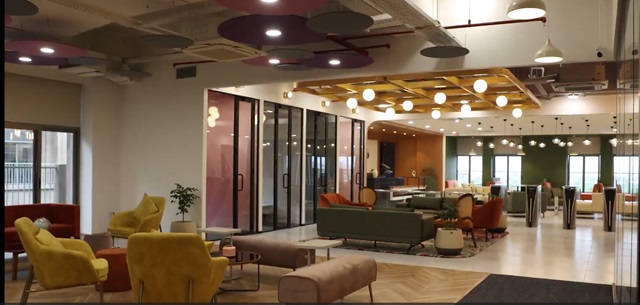
Businesses that place a high priority on the health and happiness of their workers typically see increases in productivity and staff morale, which eventually results in sustained profitability. They are drawn to organisations that strongly value traits like cooperation, variety, morality, and social responsibility.
The days of employing fear tactics and mistreatment to motivate staff are becoming obsolete. Particularly, the younger generation, notably millennials, seek work environments that embody characteristics like creativity, collaboration, innovation, inclusivity, joy, diversity, and thoughtfulness.
Creating a conducive atmosphere for employees to maximise wellbeing through workspace design can be achieved through thoughtful planning. A well-planned workspace not only enables interaction between workers and their surroundings. Conversely, an inadequately designed workspace has the potential to stifle any budding creativity, hinder performance, limit engagement, and impede innovation.
10 Ways to Maximise Wellbeing Through Workspace Design
When considering improvements to an office space or when transferring to a new site, many interior design experts stress the significance of giving both outstanding design and employee welfare top priority. To create a harmonious workplace, it is essential to strike a balance between visual appeal and employee wellbeing. 10 important suggestions to maximise wellbeing through workspace design are provided below:
1. Find Your Vision
Designing and fitting out your office space should be a reflection of your company’s culture and brand values. It’s essential to ensure that the workspace embodies the core ethos of your organisation to maximise wellbeing through workspace design. For instance, if fostering a collaborative culture with philanthropy at its heart is a priority, then your office design should resonate with these values.
Gone are the days when brand values trickled down from a distant and disconnected boardroom – today, they must be ingrained in the very fabric of your workspace to earn genuine respect. This autonomy not only enhances their sense of ownership but also minimises resistance to change, making transitions smoother and more readily accepted.
2. Work Smartly
A workspace that maximises its efficiency and boosts morale should engage the senses, catering to how it sounds, looks, feels, and even smells. This evaluation should consider various sensory aspects. Take a closer look at the workflows, team sizes and locations, desk-to-employee ratios, technology integration, meeting room availability, facilities for mobile workers, and the provision of supportive and recreational spaces to maximise wellbeing through workspace design.
3. Manage Your Lighting
The beauty of nature may be brought into the office to greatly increase productivity. According to World Green Building Council research, workers who have access to outdoor views are typically up to 25% more productive and handle calls 12% faster. Furthermore, just being exposed to natural light can raise productivity by 18%, and improved illumination in general can result in a 23% rise in output. Some people even hire office Interior designer in hyderabad
4. Proper Ventilation
According to the Council’s estimations, improved ventilation and air quality can increase productivity by up to 11% while also improving thermal comfort by 3%. Although installing complicated ventilation, air conditioning, and heating systems can be useful, these changes don’t absolutely necessitate them.
Simple indoor plants not only add visual appeal but also perform a background task by absorbing carbon dioxide and exhaling oxygen. Instead of exposing your staff to the negative consequences of sick building syndrome, actively contribute to their wellbeing by strategically arranging plants throughout your office and guaranteeing the circulation of clean air within your facility.
5. Noise Reduction
Ringing phones, continuing conversations, and a constant background hum can all significantly impair people’s ability to focus, frequently making it nearly impossible. Unwanted distractions like noise are a big factor in unhappy workers. The good news is that careful furniture and design selections can effectively alleviate this issue.
Avoid placing a general-purpose phone in the centre of an open-plan office and positioning desks where they are always in the path of onlookers. Incorporate sound-absorbing materials, strike a harmonious balance between open and enclosed spaces, and employ furniture that hinders rather than helps noise transmission.
6. Use Colours
The Green colour can reduce tension and provide a sense of serenity, blue can improve focus, and yellow can encourage creativity. Well-being can be increased by including pops of colour, artwork, indoor plants, and outdoor aspects indoors. To give your staff peaceful areas and maximise wellbeing through workspace design for encouraging creativity and a sense of serenity, think about adding water features, park-like benches, and indoor plants.
7. Enhance Your Workplace
45% of workers say they find the daily commute difficult on average. If you think it would be advantageous, you might encourage your staff to choose to bike or walk to work. Consider adding bike racks, showers, changing rooms, and locker facilities to enhance the services your business offers. This not only supports employee wellbeing but also helps the organisation project a more environmentally responsible image. You might also look into the possibilities of setting up a gym on-site or offering your personnel reduced memberships to nearby fitness facilities.
8. Take Care of Your Workers’ Health
This can be achieved by offering a range of nutritious meal options in the workplace cafeteria, setting up a juice bar, providing complimentary fresh fruit, or even creating a designated area for employees to prepare and enjoy wholesome food. These initiatives not only support your staff in making nutritious choices but also contribute to increased alertness and mental clarity.
In addition to these dietary considerations, it’s worth exploring the possibility of introducing dedicated break-out or relaxation areas within your workspace. Such spaces can also foster creativity and provide moments of respite from the demands of their desks.
9. Add spaces for a Little Hangout
According to the Get Britain Standing initiative, people spend their workdays sitting down for an average of 8.9 hours. It’s interesting that this amount of time frequently exceeds the time they spend sleeping. Particularly if you stay at a desk for over four hours each day, it can lead to discomfort, pain in your back, muscular difficulties, and even sugar levels irregularities.
Consider purchasing furniture that encourages physical exercise and discourages sedentary behaviour to address this issue. Standing desks, adjustable workstations, sit-stand stools or chairs, and balance boards have all been found to reduce muscular aches and pains, increase energy, and improve focus among office workers.
10. Remote working
The traditional nine-to-five office routine has become a relic of the past for many individuals, thanks to the pervasive influence of technology. Nowadays, people are increasingly able to accomplish their tasks remotely, at various times throughout the day and even during the night. It is prudent to explore options such as flexible working hours and the convenience of working from home or while on the move in order to boost productivity.
For those who opt to work from a physical office location, it’s essential to provide an environment that caters to activity-based working. This can involve offering a diverse range of spaces and furnishings, including multimedia rooms, standing workstations, traditional desks, and soundproof phone booths. Moreover, it’s crucial to ensure that all these workspaces are equipped with a robust and high-speed wireless connection, which is indispensable for modern work dynamics and to maximise wellbeing through workspace design.
Conclusion
To move forward, it is crucial to incorporate these crucial components into your new design and fit-out. It’s possible that you’ve already identified a number of wellbeing-related criteria, done extensive background research, consulted with all stakeholders, and created a complete project brief. Perhaps you even collaborated with a renowned workplace expert who did extensive research on your company and took the time to understand its culture and vision.
You and your team have created a workspace that smoothly combines your corporate identity with the essential element of employee well-being. Here, it’s important to keep your faith in your process’s collaborative character and the overall advantages these adjustments will offer. Stay committed; your goal of creating a workplace that promotes wellbeing will soon come true.











